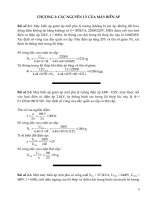Tài liệu Chapter 2: Indicators of Financial Structure, Development, and Soundness ppt
Bạn đang xem bản rút gọn của tài liệu. Xem và tải ngay bản đầy đủ của tài liệu tại đây (108.59 KB, 19 trang )
15
2
This chapter presents an overview of quantitative indicators of financial structure, devel-
opment, and soundness. It provides guidance on key system-wide and sectoral indicators,
including definitions, measurement, and usage. Key data sources for these indicators
are explained in appendix C (Data Sources for Financial Sector Assessments). Detailed
analysis and benchmarking of these indicators are discussed in chapters 3 and 4. More
detailed data requirements are presented in appendix B (Illustrative Data Questionnaires
for Comprehensive Financial Sector Assessments).
2.1 Financial Structure and Development
Indicators of financial structure include system-wide indicators of size, breadth, and
composition of the financial system; indicators of key attributes such as competition,
concentration, efficiency, and access; and measures of the scope, coverage, and outreach
of financial services.
2.1.1 System-wide Indicators
Financial structure is defined in terms of the aggregate size of the financial sector, its
sectoral composition, and a range of attributes of individual sectors that determine their
effectiveness in meeting users’ requirements. The evaluation of financial structure should
cover the roles of the key institutional players, including the central bank, commercial and
merchant banks, savings institutions, development finance institutions, insurance compa-
nies, mortgage entities, pension funds, and financial market institutions. The functioning
of financial markets, including money, foreign exchange, and capital markets (including
Chapter 2
Indicators of Financial Structure,
Development, and Soundness
16
Financial Sector Assessment: A Handbook
1
I
H
G
F
E
D
C
B
A
12
11
10
9
8
7
6
5
4
3
2
bonds, equities, and derivative and structured finance products) should also be covered.
For financial institutions, the structural overview should focus on identifying the number
and types of institutions, as well as growth trends of major balance sheet aggregates; for
financial markets, a description of the size and growth trends in various financial market
instruments (volume and value) would be appropriate. The overview should also reflect
new linkages among financial markets and institutions that may be forged from a variety
of sources, including innovations in financial instruments, new entrants into financial
markets (e.g., hedge funds), and changing practices among financial market participants
(e.g., energy trading and investments by financial institutions).
The overall size of the system could be ascertained by the value of financial assets,
both in absolute dollar terms and as a ratio of gross domestic product (GDP).
1
Although
identifying the absolute dollar amount of financial assets is informative, normalizing
financial assets on GDP facilitates benchmarking of the state of financial development
and allows comparison across countries at different stages of development. Other indica-
tors of financial size and depth that could be usefully examined include ratios of broad
money to GDP (M2 to GDP),
2
private sector credit to GDP (DCP to GDP),
3
and ratio
of bank deposits to GDP (deposits/GDP). However, one should be careful in interpret-
ing observed ratios because they are substantially influenced by the state of financial
and general economic development in individual countries. Cross-country comparisons
of economies at similar stages of development are, therefore, useful in obtaining reliable
benchmarks for “low” or “high” ratios.
The description of the number and types of financial intermediaries and markets is
also useful, and this information should be supplemented by information on the relative
composition of the financial system. Even though many countries do have a wide range
of non-bank financial intermediaries (NBFIs), banking institutions still tend to dominate
overwhelmingly. In advanced markets and in many emerging markets, NBFIs, particularly
pension funds or insurance companies, often play a larger part than do banks in domestic
and global asset allocation (and, sometimes, in the providing of credit). Similarly, market
participants such as hedge funds play an increased role in financial markets and in the per-
formance of various asset classes. Hence, for one to get a true view of financial structure, it
is useful to focus on the share of various sub-sectors (banks, non-banks, financial markets,
etc.) in total financial assets by using assets of financial institutions in different sub-sectors
and value of financial instruments in different markets as numerators. This type of focus
on market shares enables the assessor to get a quick indication of the “effective” structure
of the financial system. In addition, the presence of large financial conglomerates—also
referred to as large and complex financial institutions (LCFIs)—in the domestic market
(either foreign-owned or domestic) would warrant special attention to the scope and scale
of their activities, including exposures to other domestic institutions, as well as to intra-
group and cross-border exposures, to ascertain their local systemic importance.
4
Evaluating the overall growth of the financial system and of major sub-sectors is
important, and valuable information could be obtained by examining changes in the
number and types of financial intermediaries, as well as the growth of financial assets in
each sector over time, in both nominal and real terms. Although a description of trends
is informative, it is also critical to indicate the driving forces behind (a) observed chang-
es in institutions and their asset positions, and (b) the number of and growth rates of
17
Chapter 2: Indicators of Financial Structure, Development, and Soundness
1
I
H
G
F
E
D
C
B
A
12
11
10
9
8
7
6
5
4
3
2
available money and capital market instruments. One factor that has accounted for the
observed growth of financial systems in many countries (number of institutions and size
of assets) is financial liberalization, especially the softening of entry conditions for banks
and other financial institutions and the liberalization of interest rates, which has stimu-
lated financial markets (especially money markets). In addition, changes in prudential
regulation and accounting standards often have provided incentives for developing new
ways to manage risks (e.g., asset and liability management for insurance company and
pension funds) and have led to development of new risk-transfer instruments in capital
markets.
2.1.2 Breadth of the Financial System
Data on the financial breadth or penetration often serve as proxies for access of the popu-
lation to different segments of the financial sector. Well-functioning financial systems
should offer a wide range of financial services and products from a diversified set of finan-
cial intermediaries and markets. Ideally, there should be a variety of financial instruments
that provide alternative rates of return, risk, and maturities to savers, as well as different
sources of finance at varying interest rates and maturities. Evaluating the breadth or diver-
sity of the financial system should, therefore, involve identifying the existing financial
institutions, the existing markets for financial instruments, and the range of available
products and services. The relative composition of the financial system discussed above
is a first-cut approach to determining the extent of system diversification. In addition,
comparisons between bank and non-bank forms of financial intermediation are useful, for
instance, comparisons between banking credit and issues of bonds by the private sector.
Often, significant savings and financing through non-bank forms are indicators of finan-
cial diversity because bank deposits and loans constitute the traditional forms of savings
and credit in many countries. It is, therefore, useful to compare the extent of financial
intermediation through banks with the amount of intermediation through insurance,
pensions, collective investment schemes, money markets, and capital markets. In particu-
lar, the share of various classes of asset holders—specifically, households, non-financial
corporations, banks, and NBFIs—within the total capital market instruments or mutual
fund assets can provide valuable information on financial diversification.
To supplement the overall indicators of diversity, assessors should also focus on sec-
toral indicators of financial development. For instance, the development of the insurance
industry could be measured by examining trends in the ratio of gross insurance premiums
to GDP, which could be broken down further into life and non-life premiums. Similarly,
leasing penetration could be measured by the value of leased assets as a percentage of
total domestic investment. Table 2.1 shows a few sub-sectors of the financial system and
suggests relevant indicators of their size and development. The breadth of the financial
system also could be analyzed in terms of the outreach of existing financial institutions. A
common indicator related to this outreach is the branch network of the banking system,
in particular, the total number of branches and the number of branches per thousand
inhabitants. A comparison of the distribution of branches between rural and urban areas
or among different provinces could also be useful as an indicator of the outreach of bank-
ing outlets.
18
Financial Sector Assessment: A Handbook
1
I
H
G
F
E
D
C
B
A
12
11
10
9
8
7
6
5
4
3
2
2.1.3 Competition, Concentration, and Efficiency
Competition in the financial system can be defined as the extent to which financial
markets are contestable and the extent to which consumers can choose a wide range of
financial services from a variety of providers. Competition is often a desirable feature
because it normally leads to increased institutional efficiency, lower costs for clients, and
improvements in the quality and range of financial services provided. There are numer-
ous measures of competition, including the total number of financial institutions, changes
in market share, ease of entry, price of services, and so forth. In addition, the degree of
diversity of the financial system could be an indicator of competition or the lack thereof
because the emergence of vibrant non-bank intermediaries and capital markets often have
been a source of effective competition for banking systems in many countries. All things
remaining equal, an increase in the number of financial institutions or an expansion in
available financial market instruments will increase competition by expanding the avail-
able sources of financial services that consumers can access. Ease of entry into the system
could be judged by looking at the regulatory and policy requirements for licensing, for
example, the required minimum paid-up capital.
Table 2.1. Sectoral Indicators of Financial Development
Sub-sector Indicator
Banking • Total number of banks
• Number of branches and outlets
• Number of branches/thousand population
• Bank deposits/GDP (%)
• Bank assets/total financial assets (%)
• Bank assets/GDP (%)
Insurance • Number of insurance companies
• Gross premiums/GDP (%)
• Gross life premiums/GDP (%)
• Gross non-life premiums/GDP (%)
Pensions • Types of pension plans
• Percentage of labor force covered by pensions
• Pension fund assets/GDP (%)
• Pension fund assets/total financial assets (%)
Mortgage • Mortgage assets/total financial assets
• Mortgage debt stock/GDP
Leasing • Leased assets/total domestic investment
Money markets • Types and value of money market instruments
• New issues and growth in outstanding value
• Number and value of daily (weekly) transactions in the instruments
Foreign exchange markets • Volume and value of daily foreign exchange transactions
• Adequacy of foreign exchange (reserves in months of imports, as ratio to short-term
external debt or to broad money)
Capital markets • Number of listed securities (bonds and equities)
• Share of households, corporations, banks, and NBFIs in the holdings of securities
• Number and value of new issues (bonds and equities)
• Market capitalization/GDP (%)
• Value traded/market capitalization (%)
• Size of derivative markets
Colllective investment funds
• Types and number of schemes (unique and mixed funds)
• Total assets and growth rates (nominal and as percentage of GDP)
• Total number of investors and average balance per investor
• Share of households, corporations, banks, and NBFIs, in total mutual funds assets
19
Chapter 2: Indicators of Financial Structure, Development, and Soundness
1
I
H
G
F
E
D
C
B
A
12
11
10
9
8
7
6
5
4
3
2
In many cases, the ownership structure of the financial system can be indicative of
competition or lack thereof. For instance, banks of different ownership often have dif-
ferent mandates and clientele, leading to substantial market segmentation. Also, systems
dominated by state-owned financial institutions tend to be less competitive than those in
which privately owned institutions are very active because state ownership often dampens
commercial orientation. In some cases, the shares of domestic- and foreign-owned finan-
cial institutions in various financial sub-sectors could be relevant in assessing competition
and incentives for financial innovations.
Measures of concentration often have been used as indicators of competition.
Concentration is defined as the degree to which the financial sector is controlled by the
biggest institutions in the market (as defined by market shares). For example, the three-
bank concentration ratio measures the market share of the top three banks in the system,
defined in terms of assets, deposits, or branches. Deciding what is concentrated and what
is not depends a lot on judgment, and benchmarking becomes critical.
5
A more sophisti-
cated measure of concentration is the Herfindahl Index (HI), which is the sum of squares
of the market shares of all firms in a sector. Higher values of the index indicate greater
market concentration. When applied to the financial sector, this index uses information
about the market share of each bank to obtain a single summary measure.
6
The concept
of concentration also could be applied to financial markets, especially by examining the
share of different market instruments in the total outstanding value of financial market
instruments. For example, the relative shares of money and capital market instruments in
total financial assets could give an indication of the extent to which financial markets are
positioned between short-term and long-term intermediation. Information on holdings of
the instruments by types of investors and by number of issuers of different instruments also
helps assess market competition.
The sustainable development of a financial system and the degree to which it provides
support to real sector activities depend to a large extent on the efficiency with which
intermediation occurs. Efficiency refers to the ability of the financial sector to provide
high-quality products and services at the lowest cost. Competition and efficiency of the
financial system are related to a large extent because more competitive systems invari-
ably turn out to be more efficient (all other things being equal). Quantitative measures
of efficiency that could be evaluated include (a) total costs of financial intermediation
as percentage of total assets and (b) interest rate spreads (lending minus deposit rates).
Components of intermediation costs include operating costs (staff expenses and other
overhead), taxes, loan–loss provisions, net profits, and so forth. Those costs can be
derived from the aggregated balance sheet and income statements for financial institu-
tions. However, interest rate spreads sometimes remain high despite efficiency gains
because of the need to build loan–loss provisions or charge a risk premium on lending to
high-risk borrowers.
For money and capital markets, efficiency implies that current security prices fully
reflect all available information. Hence, in an efficient financial market, day-to-day
movements of market prices tend to be random, and information on past prices would not
help predict future prices. The bid–ask spread (i.e., the difference between prices at which
participants are willing to buy and sell financial instruments) is often used as a proxy for
measuring the efficiency of markets, with more efficient markets exhibiting narrower
20
Financial Sector Assessment: A Handbook
1
I
H
G
F
E
D
C
B
A
12
11
10
9
8
7
6
5
4
3
2
bid–ask spreads. Because bid–ask spread also reflects market liquidity, as discussed below,
additional analysis of the extent of competition in the market and of volatility of price
movements would be needed to assess efficiency. In addition, measures of price volatil-
ity are sometimes used to substitute for market efficiency, although short-run changes in
volatility may reflect shifts in the amount of liquidity in that market.
Two important dimensions of market liquidity should be considered: market depth and
market tightness. Market depth refers to the ability of the market to absorb large trade
volumes without significant impact on market prices.
7
This dimension is usually measured
by the ratio of value traded to market capitalization (turnover ratio), with higher ratios
indicating more liquid markets. Another dimension of liquidity is market tightness—abil-
ity to match supply and demand at low cost that is measured by the average bid–ask
spread. More liquid markets usually have narrower bid–ask spreads. Further discussion of
these indicators can be found in section 2.2.4.
Table 2.2 summarizes the indicators of financial system performance that have been
discussed in this section.
2.1.4 Scope and Coverage of Financial Services
The financial system provides five key services: (a) savings facilities, (b) credit alloca-
tion and monitoring of borrowers, (c) payments, (d) risk mitigation, and (e) liquidity
services.
Savings mobilization can be assessed by examining the effectiveness with which the
financial system provides saving facilities and mobilizes financial resources from house-
holds and firms. The extent of financial savings could be ascertained by examining the
level and trends in the ratio of broad money to GDP. As mentioned earlier, this indicator
may overstate the true picture if currency constitutes a high proportion of broad money.
Other more specific indicators of access to savings facilities include the ratio of bank
deposits to GDP and the proportion of the population with bank accounts.
Information on the outreach of the financial system can help interpret developments
in financial savings. Hence, indicators such as the total number of bank branches, the
population per bank branch, and the distribution of branches and other outlets (e.g., rural
or urban) could provide valuable information on the access of the population to saving
facilities. Further, it is important to assess the range of saving vehicles that are available
Table 2.2. Indicators of Financial System Performance
Sub-sector Indicator
Competition and concentration • Total number of institutions
• Interest rate spreads and prices of financial services
• Intermediary concentration ratios (market share of 3 or 5 of the largest institutions)
• Financial market concentration ratios (market share of the largest financial instruments,
as a percentage of total financial assets)
• Herfindahl index
Efficiency • Interest rate spreads
• Intermediation costs (as percentage of total assets)
Liquidity • Ratio of value traded to market capitalization
• Average bid–ask spread
21
Chapter 2: Indicators of Financial Structure, Development, and Soundness
1
I
H
G
F
E
D
C
B
A
12
11
10
9
8
7
6
5
4
3
2
because, in many countries, traditional bank deposits are the most common form of finan-
cial savings. Saving through non-bank forms of financial intermediation are, therefore,
crucial to financial diversity, and development indicators for non-bank intermediaries
such as insurance, pensions, and capital markets could be useful in gauging the degree to
which the population uses non-bank forms of financial savings. Hence, household and
corporate holdings of non-bank financial assets (e.g., bonds) could provide extra informa-
tion on the degree of access to financial savings.
The ratio of private sector bank credit to GDP is a common measure of the provision
of credit to the economy, as well as of banking depth. Often, this indicator is supple-
mented by information on the ratio of loans to total bank deposits. Where available, the
volume of finance raised through the issuance of bonds and money market instruments
should supplement information on bank credit. Analyzing trends in those indicators
should reveal the overall degree to which the banking sector provides credit to firms and
households. It is also useful to assess the sectoral distribution of private sector credit to
gauge the alignment of bank credit with the distribution of domestic output. Therefore,
the relative proportion of total credit going to agriculture, manufacturing, and services
would be relevant information in evaluating the adequacy of the level of credit provided
to the economy.
A key function of financial systems in market economies is to offer fast and secure
means of transferring funds and making payments for goods and services. The state of
development of the payment system is of interest here, especially the focus on the various
instruments for making payments, including cash, checks, payment orders, wire transfers,
and debit and credit cards. The proportion of payments (volume and value) made with
different payment instruments can reveal the developmental status of the payment sys-
tem, with cash-based economies at the lower end of the spectrum. Some indicators such
as the number of days for clearing checks, the number and distribution of clearing centers,
and the volume and value of checks cleared could provide general information on the
effectiveness of existing money transfer mechanisms. In addition, it is relevant to examine
the various risks associated with the payments system, through indicators such as access
to settlement credit, size of settlement balances, and so forth, thereby complementing the
qualitative information from assessments of Core Principles for Systemically Important
Payment Systems.
8
The major risk mitigation services offered by the financial system include insur-
ance (life and non-life) and derivative markets. The ratio of gross premiums to GDP is
a popular indicator of development in the insurance industry, and this indicator could
be supplemented with a breakdown of premiums between life and non-life insurance.
A deep and well-functioning insurance industry would offer a wide range of products in
both the life and non-life business, including motor vehicle, marine, fire, homeowners,
mortgage, workers’ compensation, and fidelity insurance and life insurance, as well as
disability, annuities, medical, and health insurance. In addition, coverage of derivative
markets—options, futures, swaps, and structured finance products––where relevant in
terms of available instruments, liquidity, and transaction costs, would be important, owing
to their role in managing risk and in facilitating price discovery in spot markets.
Liquidity service provided by financial systems is reflected in maturity transforma-
tion and secondary market arrangements, which facilitate investment in high-yielding









